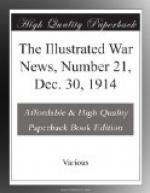[Continued opposite.
_______________________________________________________
___________________ THE ILLUSTRATED WAR NEWS, DEC. 30, 1914—[Part 21]—29
[Illustration: THE ENEMY AS PORTRAYED BY HIMSELF ON CHALK: THE GERMAN SOLDIER-CAVEMAN AS ARTIST IN THE AISNE QUARRIES.]
Continued.]
the Aisne battlefield, while making use of the cover of the quarries and natural excavations of the district along the northern side of the river. In very much the same way, as modern exploration has brought to light, the primaeval cave-dwelling inhabitants of Europe in prehistoric times left rudimentary traces of their presence in certain places in the shape of carvings and roughly painted “portraits” of themselves, of the creatures they hunted for food and fought with, and of the implements they used. According to the German newspaper from which we reproduce the illustrations given here, they are the work of a German artist who has had to go to the Front as a conscript and serve in the ranks of an infantry battalion.
_______________________________________________________
___________________ 30—THE ILLUSTRATED WAR NEWS, DEC. 30, 1914.—[Part 21]
[Illustration: AS LEFT BY THE TRAITOR, DE WET: THE UNION JACK THE REBEL LEADER TORE AND TRAMPLED UPON AT WINBURG.]
De Wet committed his first open act of rebellion at Vrede, on October 28. There, with a hastily raised commando at his heels, he forcibly seized the place and, after submitting the local officials to brutal ill-treatment, in a wild, incendiary speech called on the Dutch of South Africa to rise in arms against the British Government. It was at Winburg that De Wet performed, as it is stated, the theatrical and unworthy outrage of trampling on and tearing the Union Jack. The identical flag which suffered the maltreatment is shown in our photograph, in the state in which it was after De Wet’s puerile act of defiance had been committed. Reparation and atonement are to come, as we shall learn when De Wet faces his court-martial, probably at an early date.
_______________________________________________________
___________________ THE ILLUSTRATED WAR NEWS, DEC. 30, 1914—[Part 21]—31
[Illustration: “GLORY TO THOSE WHO HAVE FALLEN!” MEN OF THE HEROIC FRENCH ARMY WHO HAVE DIED FOR EUROPEAN FREEDOM.]
This tragic photograph, showing the fatal effects of a German shell among some French soldiers, brings home to the mind what “death on the field of honour” means. The Premier of France, M. Viviani, in his great speech at the opening of the Chambers, paid an eloquent tribute to the French Army. “We have,” he said, “the certainty of success. We owe this certainty ... to our Army, whose heroism in numerous combats has been guided by their incomparable chiefs from the victory on the Marne to the victory in Flanders.... Let us do honour to all these heroes. Glory to those who have fallen before the victory, and to those also who through it will avenge them to-morrow! A nation which can arouse such enthusiasm can never perish.”—[Photo. by Alfieri.]




